First Steps to Real Food
Are you working to ditch processed foods and put more real food on the table? This month we’re running a series called Real Food Made Simple: A Beginner’s Guide to Eating Better. Our goal is to answer the questions you might have and make the transition a whole lot easier!
Written by Stacy Karen, Contributing Writer
Transitioning your family to a real food diet can seem overwhelming. There is so much to learn, new foods to try, cooking techniques to master, and shopping strategies to implement.
Once you begin to learn about the harmful effects of our modern-day diets and the benefits of real food, it is tempting to change everything at once.
But contrary to this strong urge, it is often better (and more feasible) to take things slowly and implement one or two changes at a time.
Modifying your diet in this way will help ensure lasting change and also minimize resistance from your family.
The following are the first steps I recommend. Choose one or two to begin with and add another every few weeks (once you feel that the previous step has been mastered).
Replace margarine with butter.
This step is fairly easy since butter can be used in most any way that margarine is. I know many people fear using butter because of its fat content, but let’s think about the food content for a moment (and will get to fat later – the right fat is not bad, including butter):
Butter = Cream (and possibly salt)
Margarine = Canola and sunflower oils, water, modified palm and palm kernel oils, salt, whey protein concentrate, soy lecithin, vegetable monoglycerides, potassium sorbate, vegetable color, artificial flavor, citric acid, vitamin A palmitate, vitamin D3, alpha-tocopherol acetate.
It’s easy to see which one is real. Our body can tell the difference, too!
Replace vegetable and canola oils with coconut and olive oil.
Most cooking tasks can be handled with coconut oil and olive oil. These oils are nutritious and don’t harm the body. Yes, canola is touted as a “healthy oil,” but it is far from it. To learn more about the history of canola oil and why it is bad for you, read this article: The Great Con-ola.
Reduce white flour in homemade baked goods.
Slowly replace white flour with whole wheat flour. For example, if a recipe calls for 1 cup of white flour, replace a 1/4 cup with wheat. It may go unnoticed! Gradually increase the amount of whole wheat flour in baked goods and slowly eliminate the white flour. This will be less painful than suddenly offering 100% whole wheat muffins to your children.
Increase consumption of vegetables.
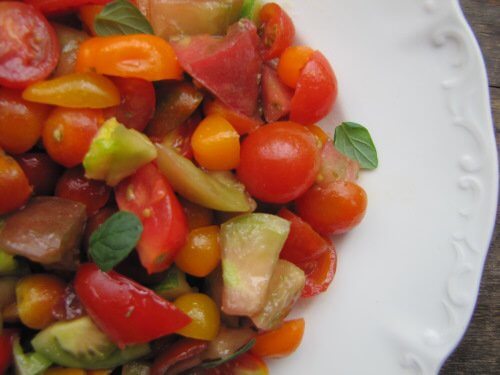
{Simple and Fresh Tomato Salad}
Make an effort to eat at least one or two vegetables with every meal, working up to more. Branch out and try something new once a week. You might be surprised about some flavors the family actually enjoys.
Here are three posts to help you get started:
How to Cook Vegetables: Steaming, Pan Cooking and Lots of Tasty Recipes
7 Ways to Add More Veggies to Meals You’re Already Cooking
Fast and Frugal Snacks Straight from Your Garden
Eliminate soda.
I understand that this can be a tough one if you drink soda regularly. It’s OK to cut down gradually, but make getting rid of soda a priority. You already know that soda is bad for you, completely unnatural and full of sugar (or artificial sweeteners).
Try other drinks such as kombucha or water kefir (which are somewhat bubbly) or flavor water with a slice of lemon or lime.
Commit to avoiding artificial sweeteners and high fructose corn syrup in store-bought products.
Once you are ready to replace condiments (such as ketchup) and snacks (like granola bars), look for items that are free of corn syrup, aspartame, and other artificial sweeteners such as Sucralose, Saccharin, and Acesulfame K.
Store-bought snacks that meet this criteria might be difficult to find (or too expensive), which leads me to the next step:
Replace some store-bought snacks with homemade goods.
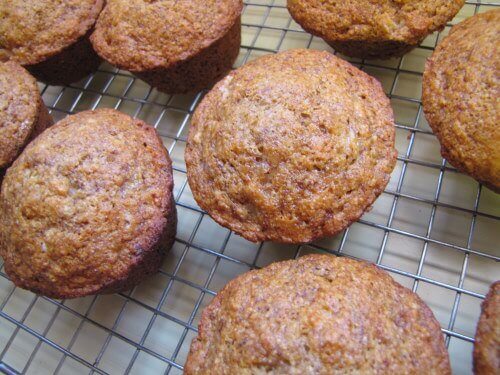
It is quite easy to prepare wholesome cookies, cereal bars, energy balls, muffins, and other real food snacks at home.
It is also helpful to experiment with other forms of snack foods such as carrots and hummus, fruit, and so on. It is important to remember than snacks are not just a stop gap for hunger, but also a way to increase overall nutrition. Make them count.
Check out these posts for more ideas: Read Food Snacks for Kids – 45 Ideas and 10 On-the-Go Healthy Snack Ideas for Toddlers.
Katie of Kitchen Stewardship also has a great homemade snacks cookbook called Healthy Snacks to Go.
Experiment with breakfast options
Boxed cereal or toast are some of the most common breakfast foods, however, I think most of us know that while they are convenient, they don’t pack much of a nutritional punch.
Try some other options such as baked oatmeal, protein pancakes, bacon and eggs, or breakfast casserole.
Don’t attempt to make something new every day; instead, gradually replace boxed cereal with more healthful options. Perhaps start out with a new breakfast only once a week and work up from there. If you have older children, be sure to teach them how to cook these new foods, so they can help!
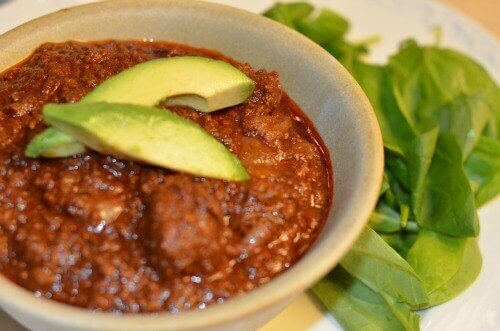
This Chocolate Chili is delicious.
Set aside time to cook.
Eating real food it much more affordable when you are making things from scratch. Before attempting to tackle any of the steps above, I recommend looking at your schedule and carving out some time for menu planning and bulk cooking (if it’s not there already). Taking an afternoon or evening to prepare some healthy snacks, precook meat, and put together a large salad will make it easier to eat real food on a daily basis.
If the moment of hunger strikes and there is no real food on hand, it becomes difficult to stay on track. Being prepared is key to your success.
Begin to gather real food recipes.
There are a lot of real food recipes online. I often find it easier to search for a new recipe with whole food ingredients than to modify a family favorite. Not to say that favorites can’t be successfully adapted to real food guidelines, but it is often best to save these for unhurried times.
Collect recipes from around the web that you find interesting. Get your family involved by showing them some delicious-looking meals and ask them to choose one or two to try.
Get familiar with the outer aisles of the grocery store.
You will find most real food ingredients in the outer aisles of the grocery store. Most often, the deeper you go, the more refined the food becomes. Spend some time looking around the produce and meat departments and see what is available. This is where you will be buying most of your food.
Implementing any of the above steps is a worthy use of your time. Each one will become easier as you practice, and one day, eating like this will seem like second nature.
Other posts in the series:
Real Food Made Simple: A Beginner’s Guide to Eating Better
Cutting Your Kitchen Prep Time in Half — Or More!
Confessions of a Formerly Picky Eater
The Grain Controversy: Should We Eat Them or Not?
Second Steps Towards Eating Real Foods: Switching Your Food Sources
Sweeteners: How They Affect You, Which Ones are Best, and How to Use Them
Simple Steps to Begin Cooking Homemade: Pantry Staples
5 Strategies to Help Your Husband and Kids Transition to Real Food
Finding Real Food in the Grocery Store
20 Easy Real Food Switches and Substitutions {with Free Printable Chart}
First Steps to Eating for Fertility
Keeping Costs Down in a Real Food Kitchen
5 Ways to Get More Fruits & Veggies into your Diet
Food Is Not Cheap: 4 Steps to Budgeting in Real Food
Simple Steps to Begin Cooking Homemade: Baked Goods
Simple Roast Chicken (And Fabulous Side Dish Recipes!)
17 Homemade Spice Mixes {with Recipes & Why You Should Use Them!}
5 Ways Green Living and Real Food are Connected
Simple Steps to Begin Cooking Homemade: Soups, Sauces, and Simple Dinners

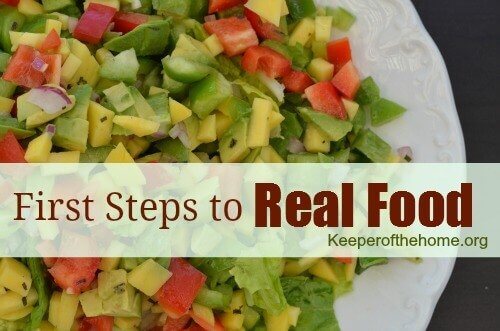

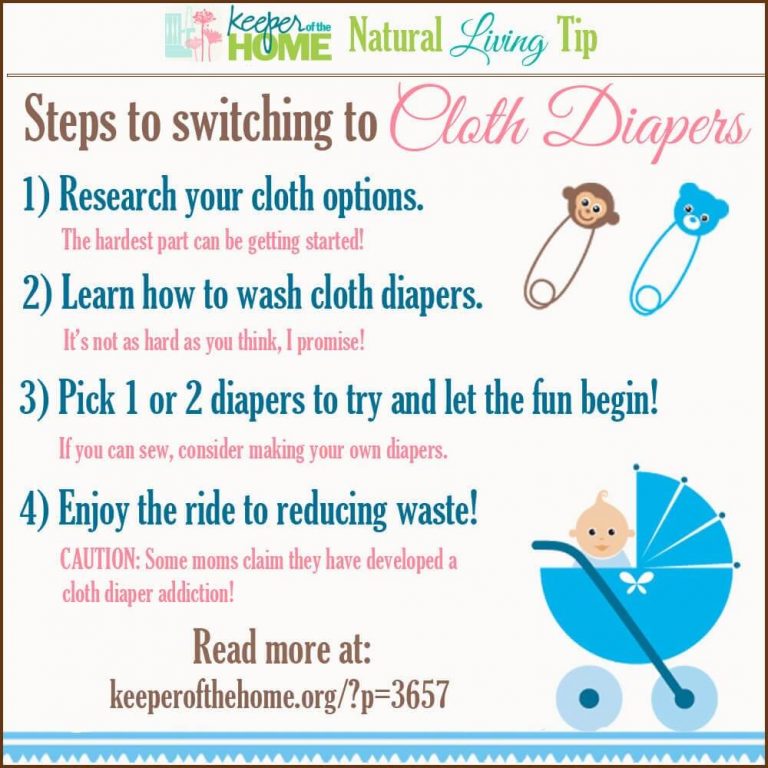

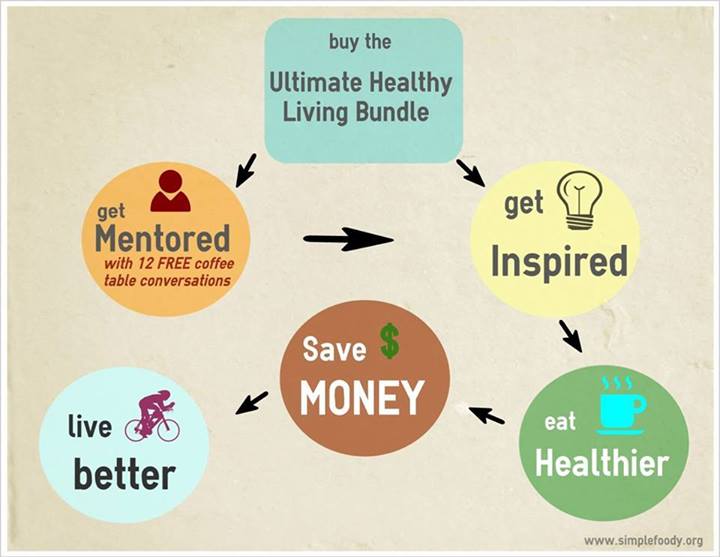

Wonderful post! Thank you for these tips and resources. I am learning to cook food from scratch and recently made an easy batch of homemade granola bars. (recipe from Biblical Homemaking) I like these steps though because they are small and easy to implement.
Thanks again!
Regarding the butter, I can’t have dairy of any kind because my exclusively nursed son reacts to it (as well as gluten & chocolate. :(. ). So I use soy free Earth Balance. Is it really that bad?
Amanda, I was in the same boat until a few weeks ago. (My little guy is a year now, and seems to be tolerating some dairy now. I hope yours gets to that point soon too!) I bought one tub of soy-free Earth Balance and use is when I really want butter-type things like for garlic bread. I think it’s a whole lot better than most of the standard margarines, but probably not good enough that you’d want to use it in the same quantities as butter. (Others, feel free to disagree 🙂 ) If I was making a grilled sandwich, I used olive oil instead of butter on the bread. Coconut oil instead of butter in granola bars and popcorn. Olive oil instead of melted butter in other recipes. And I frequently just did without the item, like in hot wings sauce. I hope that helps a little bit, and best wishes as you continue the elimination diet for your son’s sake! You can do it 🙂
Thank you! 🙂
Oh, Stacy, thank you so much for this list. Somehow, seeing everything put like this made it seem less overwhelming. We’ve replaced the margarine, next step in the white flour to wheat. And replacing our cereal for breakfast (the littles call cereal “breakfast.”) with something more nourishing.
You’re welcome, Lindsey. Keep up the great work. You can do it!
Stacy, this is an EXCELLENT list!!! What a great way to break it down! Out with the margarine! BLECH!
This is such an excellent list. Really do-able and encouraging for those who have no idea how to actually start!
Thanks for this series! It is so helpful to have small ways to start living healthier with a real food diet. I do about half of these already. I would like to work on making better breakfasts and get the cereal boxes out of the house.
I appreciate your blog- it has been very beneficial over the past couple of years in my quest to transition our family nutritionally. I continue to read and research different things and have come across the book “Wheat Belly”. Wondering if you had read it and your thoughts?
The next step I want to tackle is cooking in bulk, but I need a place to put it all! Any recommendations for chest freezers?
thank you so much for doing this. it is overwhelming to switch to real food. there is so much info out there and its confusing and hard to start. you have made it much easier. i really appreciate it.
I just started trying to live a simple and healthy lifestyle and it seems overwhelming but thanks for your suggestions and I am going to start slowly as you suggested. Thank you for the encouragement!
I started to change things one at a time this last summer. The first thing I replaced was white table salt with sea salt. That was hard for hubby! Then I convinced him to buy coconut oil to replace veg oil. That one took longer to be a regular thing because the coconut oil is twice as expensive as veg oil, and that bothered him. I refused to use the veg oil and it made for some stressful times, but I stuck to it and so glad I did. I’ve changed a lot of my eating habits, hubby still isn’t convinced he needs to live a healthier food life. However, he agrees that the kids and I should eat this way.
These are great tips!!
One note on the replacement with whole wheat flour: this can be much more diffucult to digest without soaking. And of course it’s a huge step to go from white flour goods to soaked whole wheat flour goods. I would suggest using sprouted flour instead of whole wheat. Anytime you use whole wheat flour you should really soak or sprout (soaking is probably easier).
Amanda, have you tried ghee instead of butter? Many who react to dairy can do ghee with no issues. If you still can’t, then the Earth Balance is probably ok (though I haven’t read the ingredients). Soy free is definitely a plus. You could also make ‘unbutter’ which is basically a mixture of coconut oil, some olive oil, salty water and lecithin. You whip it up and it hardens in the fridge to consistency of butter (it’s yellow from the lecithin).
So sprouted wheat is easier to digest? You seem to know your stuff a little better than I do, just curious, do you know why a recipe would have some serious problems when trading out the white flour for wheat flour? I have a bread recipe that works fine if I use more wheat than white but the second I try to all wheat the recipe it doesn’t rise and kind flattens in the oven even if it did rise?
Thanks Magda! Where do you get lecithin? What is it derived from? I have only ever seen soy lecithin listed in products. I’m allergic to soy. What does ghee taste like?
I have already started to eat healthier. I got a Misto sprayer for olive oil. It is better and much less expensive than buying the cooking sprays. I love my Misto and don’t know how I made it without it. I also love coconut oil. It is good for the inside and the outside of your body. I am trying not to use anything on my body that I wouldn’t put in my body. With the exception of my homemade soap. I wouldn’t want to eat that! But is is really moisturizing to your body. The only thing I use in it that I wouldn’t put in my body is the Lye. (Which can be made from wood ashes.)
@ Amanda, I think that is amazing you’ve been able to exclude dairy from your diet to maintain your goal to nurse your son! That takes a lot of discipline. Earths Balance has great options for having a diet that requires you to be dairy free and gluten free. I think a great thing about them as well, is they are verified non-gmo. You can read a little bit about their company in the link below. From what I’ve seen, from their products are plant based, vegan, and much more! I think its a great healthy substitute to butter! http://www.earthbalancenatural.com/responsibility/
Thank you!!! It does take discipline but, because I wanted nursing to work out SO badly this time around, it’s all the motivation I need to make it easy. Thankfully things have been going much better this time aside from poor little guys tummy & reflux issues (which chiropractic care helped eliminte!). He just turned 4 months yesterday & we are still going strong. 🙂
Amen to that!
We’ve been slowly transitioning to a real food diet since my first baby was born 2 years ago. The biggest headache is when people outside the home life don’t get it. . . Like my mom, or hubby’s, or . . well you get the idea. But one thing I did notice that might need further research is that I had horrible horrible allergies, Milk made me ill and so did wheat. Now we eat only organic wheat and our Milk is as close to Raw as we can get right now, and I. Have. No. Allergy. Symptoms. Is it possible that the conventional wheat and milk supply are being tainted?
Just something to think over for some who are counting the cost. The overall health improvement my family had in the two years we’ve been at this has been over and above worth the cost! And I’m just talking about the Milk and Wheat! Of course other things are continually going more natural and etc. but whenever we eat out we can tell what a difference the diet has made in our lives by how much better we feel with the real food. An old family friend used to call eating organic and natural his health insurance plan and I am starting to too!
I totally still think of myself as a beginner but after reading this I feel like I have progressed a long way. Thank you for this article. I really needed this boost because I keep second guessing myself. Sometimes I just feel too tired, after working all day, taking care of my side business, my household chores, my pets, my husband and family, and cooking…. all the fermenting, the making kefir, feeding the sourdough starter, making bone broth and making sure I have enough coconut oil every day, gets to be so exhausting. How do people do it with multiple children? They are amazing!
I really needed this series,so thank you. I have done the easy switches in the last 3 weeks. I just made my first CC cookies with Sucanut and spelt flour, but I kept in the reg brown sugar from the store. My family loved them. I’m having alot of luck with the organic spelt flour. Is this just as good as whole wheat? Also I bought some kombucha already made from the local co-op just to try before I decided to spend the money to make my own. I’ve been buying small amounts of things to try them before I decide to go all out and large quantities. So glad to have this web site to refer to.
Sounds like you’re making great switches. That’s so awesome! 🙂
I try to eat clean, real food but the hardest thing to get away from is packaged noodle and rice mixes….so easy for busy working moms. So I am really going to try to stop using these.
You’re right. Those are convenient. I did some precooking of rice for the freezer and it put into small bags. It seems to work OK.
This is excellent! Good work, Stacy!
Where does organic grape seed oil fall on the real food scale? Is it comparable to coconut oil in its nutritional values? I have been reading that grape seed oil is high in omega’s and I like its high smoke point. I’ve been using it for years and would like to continue if it helps.
Hello! I’ve been reading your posts for a long time and really enjoy then, so thank you! I was inspired a couple of years ago to try to improve what I was putting into my body and while Im not amazing at it, I celebrate the successes of simply not buying very much processes foods and making efforts to make them myself from scratch with fresh ingredients. My boyfriend would prefer a fast put together meal that comes out of a box to save time, but Im working on showing him how much better food is when you cut the meat and veggies fresh and use a recipe. My main vice is I drink one coke most days. I’ll have to evaluate that as I saw that on the list. 🙂 Thanks again!
What would you recommend as a healthy alternative to olive oil? I’ve recently found out that my son is allergic to olives (and nuts, soy, tuna, cod….). I’ve been using canola oil with some butter and coconut oil here and there, but now I’m not sure what to replace the canola with…. suggestions?
I wouldn’t suggest using either of these in large quantities, but you could use some unrefined grapeseed oil or sunflower oil. As long as they’re cold-pressed/virgin oils, they can be a good choice, but they’re not something I would want to use too much of. If you can keep most of your oil use to butter and coconut oil, or consider things like beef tallow for high temperature cooking, that would be better.
Have you considered not using oil at all? I don’t consume oil in any way. I sauté’ all veggies in either water or veggie broth (or nothing at all). I cook with out oils in my baking as well. Take a look at a plant strong recipe from someone like Happy Herbivore or Engine 2 Diet for ideas.
Not using oils is REALLY clean eating!
This is a great post. I’m at the point where I’ve done most of this, but we can always improve, can’t we? I think I need to up my whole wheat ratio again. I move it up and then back down because using whole wheat makes my breads and dough so thick and dense. I suppose it’s just getting used to it though… just like anything else.
The big thing I need to work on is switching out store-bought snacks for homemade ones. This is huge for me. I’m busy, and I tend to buy things that are convenient… healthy but convenient for my kiddos. I need to start setting aside healthy recipes for snacks and taking the time to make them. I’m looking forward to the rest of this series!
Oh, I feel so much better knowing I have done some of these things! I honestly get a little tired of and overwhelmed by all the complicated ins and outs of “natural living” (ferments and fish oil supplements and soaking and no sugar and no grain… no thank you!), as we have no food allergies or health issues in the family and I mostly stick to my theory of “everything in moderation”. I love being able to find the simple things I can do the made our food habits healthier! We have been using butter and avoiding soda for several years, avoiding artificial sweetners for about a year now (except high fructose corn syrup, a lot more lax on that one), and I mostly use olive oil instead of veg oil. I found coconut oil at only 1 store so far and it was 4x the cost of olive oil! So until I win the lottery, I will stick to olive oil 🙂 Struggling with “setting aside time to cook” though… I can barely get dinner on the table, yet alone set aside a day just to cook. But I am working hard to buy less processed/fewer preservatives/fewer unnatural ingredient foods! Thank you so much for helping me realize I AM doing some good things!
Something I do to help make extras, also being on time crunch, is to double the recipe I’m making for supper, then I can freeze the other half before its served. Otherwise, my husband might think there’s room for fourths.
I also look for recipes similair to what my husband already likes to eat, and find ways to make them healthier i.e. meastloaf- use oats instead of bread crumbs
baked sweet potato fries instead of regular fries
A brilliant post, thanks!! I do a few of these already but the one I have been stuck on for a while is replacing margarine with butter. I find that butter from the fridge is too hard and difficult to spread for me and my toddler. But can it be stored out of the fridge? What about bacteria / pests? I live in a hot climate (Brisbane). Any tips for how to soften butter or get round this problem would be greatly appreciated!! Thank you x
My mother-in-law found me a “butter bell” or butter crock. It keeps the butter out of the fridge and soft, but uses water to seal the part where the butter is kept and keep out germs/yuckiness from being at room temp. Perhaps you could find one near you?
Butter keeps great out of the fridge. Not for forever….but for at least a week, I’d say. Give it a try!
I love how this gives people a very practical place to start their journey! Thanks for sharing! I’m going to be linking to this article on my Friday Features post today 🙂
This is a great, organized list for getting started on healthier eating. I’m a checklist kind of girl, so it is satisfying to check off a few I am already doing, and helpful to set my next goals.
I am pretty much terrified to make this change. I’m a working mom and not terribly domestic and I have three men to feed all of whom dislike just about anything that could remotely be called “good for them”. I like the idea of starting small. I think I’ll start with butter, and a new breakfast recipe. My sons usually eat bacon and eggs or a breakfast sandwich (at least I make that with whole foods–I think, lol), but I love cereal. But I think breakfast might be the easiest place to start for us.
Here’s a dumb question: How can you make butter spreadable? Like, you can’t leave it out so it’s soft, right? Because it needs to be refrigerated? What about those whipped butters? No good?
Thank you so much for this series!
That’s not a dumb question. You can actually leave butter out and it will be fine. I just keep it in a glass pyrex container with a lid on it and store it in the cupboard. It would take a long time to go bad this way. If you’re worried about it, just put small amounts in the container at a time, and then you can always have soft, spreadable butter.
Breakfast is definitely a great place to start. I think it’s amazing that you’re going to do this, even though you’re scared to do it. That makes you an amazing mom and wife, taking care of your family like that. 🙂
I was so excited when I found that you can still get countertop butter crocks: http://amzn.to/W0sCdx
My grandma had one when I was a kid. You just put cold water in the crock, pack a softened stick of butter into the cup, and submerge it in the water. Change the water every 2 or 3 days. If you find it growing a bit of mold, put it in a cooler spot in your kitchen and add a pinch of salt to the water. 🙂 I love having perfect spreadable butter all the time.
Love it Love it!!!!